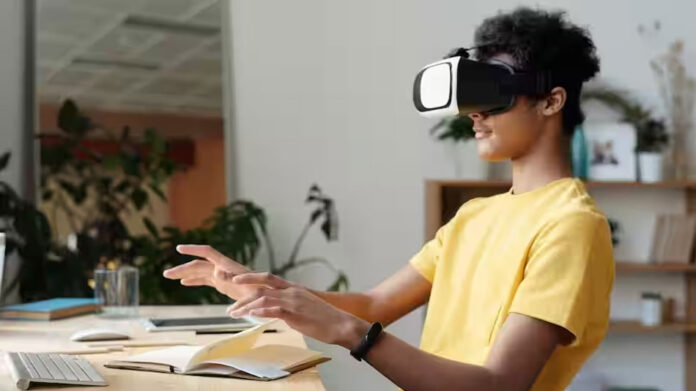Table of Contents
Students’ trends in technology vary depending on the latest tech advances, novelties on the market, their needs, etc. However, several technological trends remain popular among students no matter what. These are Artificial Intelligence (AI), Virtual Reality (VR), and Blockchain.
These are three significant technological trends that have gained immense popularity among students in recent years. No wonder why. They promise almost limitless potential and great changes in many professional and personal spheres, including education. So, let’s explore each of these trends to how they impact student life.
Artificial Intelligence (AI)
AI involves the development of intelligent machines capable of performing tasks that typically require human intelligence. Students are increasingly interested in AI due to its potential to revolutionize various fields, from creative areas to finance and education. Let’s explore some of the key interests in AI for students.
Machine Learning
Machine learning technology enables computers to learn from received data and make predictions or decisions without direct human interference. Students are most interested in exploring applications such as image recognition, natural language processing, and other personalized learning software that allow correct and adjusted study processes.
Robotics
You don’t need to go far to understand how robotics can interest students. AI-powered robots fascinate students because they offer hands-on experience in building and programming autonomous machines. Robotics competitions and clubs have become popular among students, fostering creativity, problem-solving skills, and teamwork.
Ethical Considerations
The rise of AI has also provoked more discussions and debates about ethics in the tech world. With the introduction of AI-powered technology, the world will change, leaving many ethical and moral questions unanswered. Students worry about privacy concerns, the impact of AI on jobs, the future work market, and society as a whole. Thus, students engage in extensive research to address these issues. You can also take part in the discussion. Read these 8 reviews on writing services to choose writers who can tell you about the prevailing ethics discussion so far.
Virtual Reality
The world has long been expecting great progress and the full insertion of VR technology in modern-day life. Such technology can revolutionize learning approaches, the entertainment industry, therapy, and many more areas of life. Students are always captivated by the immersive and interactive nature of VR. These are the areas deserving of our biggest attention.
Education and Simulations
VR allows students to experience virtual field trips like visiting historical sites or museums. It also allows us to explore complex scientific concepts in a realistic but safe manner. It also provides realistic simulations of environments and scenarios that may be difficult or impossible to experience in real life. VR enables students to practice surgical procedures, explore outer space, or visit ancient civilizations, ensuring a safe and controlled environment.
Gaming and Entertainment
The gaming industry is among the most promising areas for VR technology. Games in VR can offer an excessively immersive and thrilling experience. Students can enjoy exploring virtual worlds, solving puzzles first-person, and competing in multiplayer games with peers and other players.
Design and Creativity
Students interested in art, architecture, and design can use VR for practice or even art creation. VR technology allows us to apply the same rules, skills, and techniques as in the real world. Yet, students save costs on materials and mistakes by creating in a visual studio. These students can use VR to create virtual sculptures, architectural models, or immersive storytelling experiences. Thus, VR tools provide them with new ways to express their creativity and artistic nature.
Remote Learning
VR platforms can further promote the idea of virtual classrooms and remote learning. Here, students can attend virtual classrooms as if they go to real-life schools. They can see other students, engage in discussions with each other, participate in group projects, etc., without the need to be in one physical space. Meanwhile, you can learn how to improve your study experience at home by reading this review at yardyum.com.
Blockchain
Finally, students are fascinated by the idea of blockchain technology. This technology may not appear as exciting as the previous two. Yet, it carries the immense importance of the future of most of our transactions, records, and data storage. While commonly associated with cryptocurrencies like Bitcoin, blockchain has applications beyond finance, including education. Here’s how blockchain technology can impact education.
Secure Credentialing and Certifications
Blockchain can be used to create secure, unhackable, and reliable e-certificates. Now, educational institutions can issue digital diplomas, degrees, and certifications on the blockchain, ensuring their authenticity and preventing fraud. Students can have control over their credentials, securely sharing them with employers or other institutions.
Intellectual Property Protection
Blockchain can help protect intellectual property rights in the digital realm. Students and educators can register their work, such as research papers or creative content, on the blockchain, establishing proof of ownership and timestamps. This can prevent plagiarism and ensure the proper rights of intellectual property.
Efficient and Transparent Transactions
As mentioned above, blockchain offers an effective way for educational financial and administrative processes. For example, students can pay their tuition and enrollment fees and conduct other transactions. By eliminating intermediaries and providing transparent and secure records, blockchain can reduce administrative costs, increase efficiency, and prevent fraud or errors.
Social Impact
Students also recognize the blockchain’s potential in addressing various social issues, from identity theft and verification to secure voting systems online. They may be the first generation to utilize blockchain in major aspects of our political and social lives, striving for positive social change.















